Python - C++ bindings
30 Dec 2017I love python. It’s just so easy to develop anything in python. More often than not, all I need to do is add import module and few more lines of python code. I come from a systems programming background. Before python, I had only used strongly typed langauges. Coming from that background, python seems like magic.
Using python’s easy interface is fun. It’s often not as much fun to develop that interface though. It’s not easy to write efficient and robust modules in python. It’s easy to see why. While a lot of modules can be implemented in pure python, they often lag in performance. If all you care about is performance from your code, one option is to simply write C++ code and use it in other C++ modules. But, it’s really painful to go back to doing everything in C++ after using python for a while.

Python-C++ binding is a nice compromise that delivers the best of both worlds. We get to use Python’s easy interface and we get to enjoy the performance benefits of C++. Let’s review few of the options.
CPython
The official python implementation is called CPython. I guess that’s because the python core is implemented in C. There are other variants of python available out there: PyPy, Jython, IronPython. However, most people usually mean CPython when they say they wrote a python program. CPython exposes a C API to write modules in C. This is the most native way to add an optimized C/C++ module in python.
This is how most of the python’s core modules are written.
Example module with functions
Let’s consider the following example:
We want to create an example module containing a pants() function.
example module
|-> pants() function
First things first. Let’s add the following line in our example-pants.cpp file.
#include <Python.h>
It will import everything needed to define our example module. The most important part is PyObject. Everything in python is a PyObject. That includes everything from int, str, list, dict and None.
Next is PyInit_example function. It has to be in the format PyInit_{module_name}. PyModule_Create function creates a module object. Module is also a PyObject. We haven’t yet defined example_definition - it’s simply a struct listing module properties including module functions.
PyMODINIT_FUNC PyInit_example(void) {
Py_Initialize();
PyObject *m = PyModule_Create(&example_definition);
return m;
}
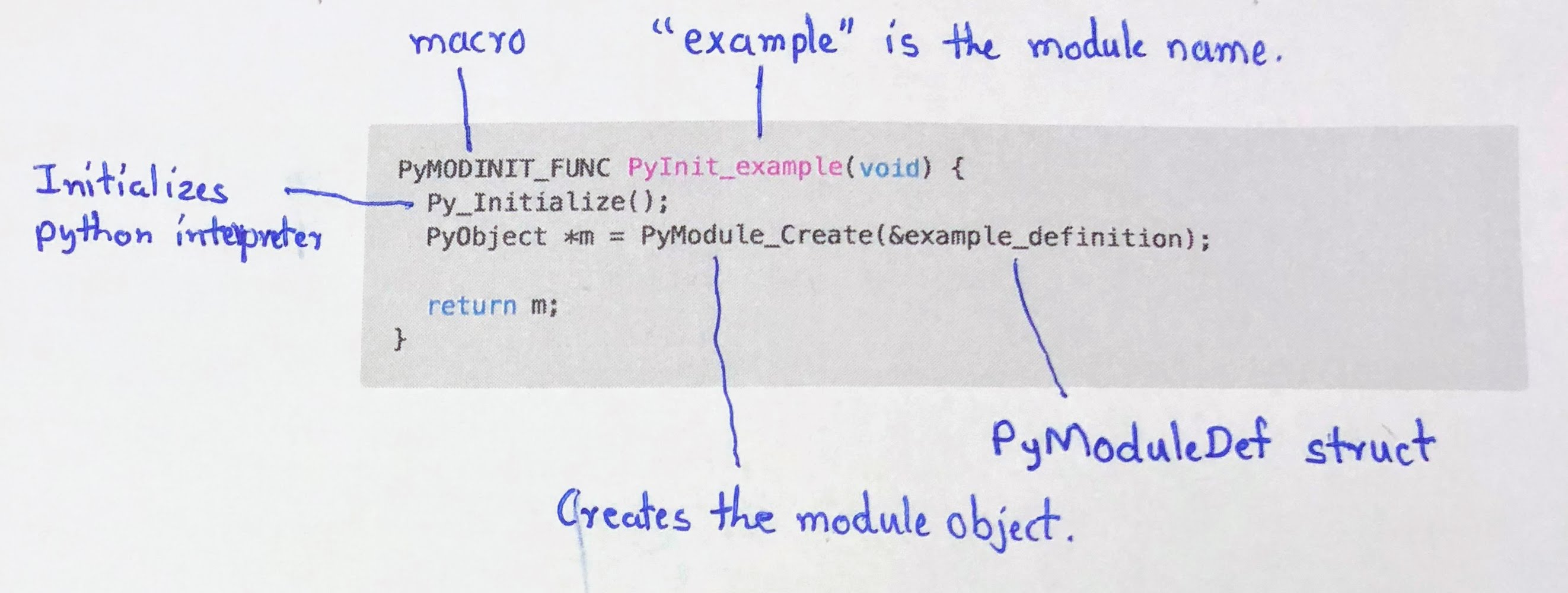
Let’s define our example_definition struct now!
static PyMethodDef example_methods[] = {
{"pants", pants, METH_VARARGS, "Returns a square of an integer."},
{NULL, NULL, 0, NULL}
};
static struct PyModuleDef example_definition = {
PyModuleDef_HEAD_INIT,
"example",
"A Python module containing Classy type and pants() function",
-1,
example_methods
};
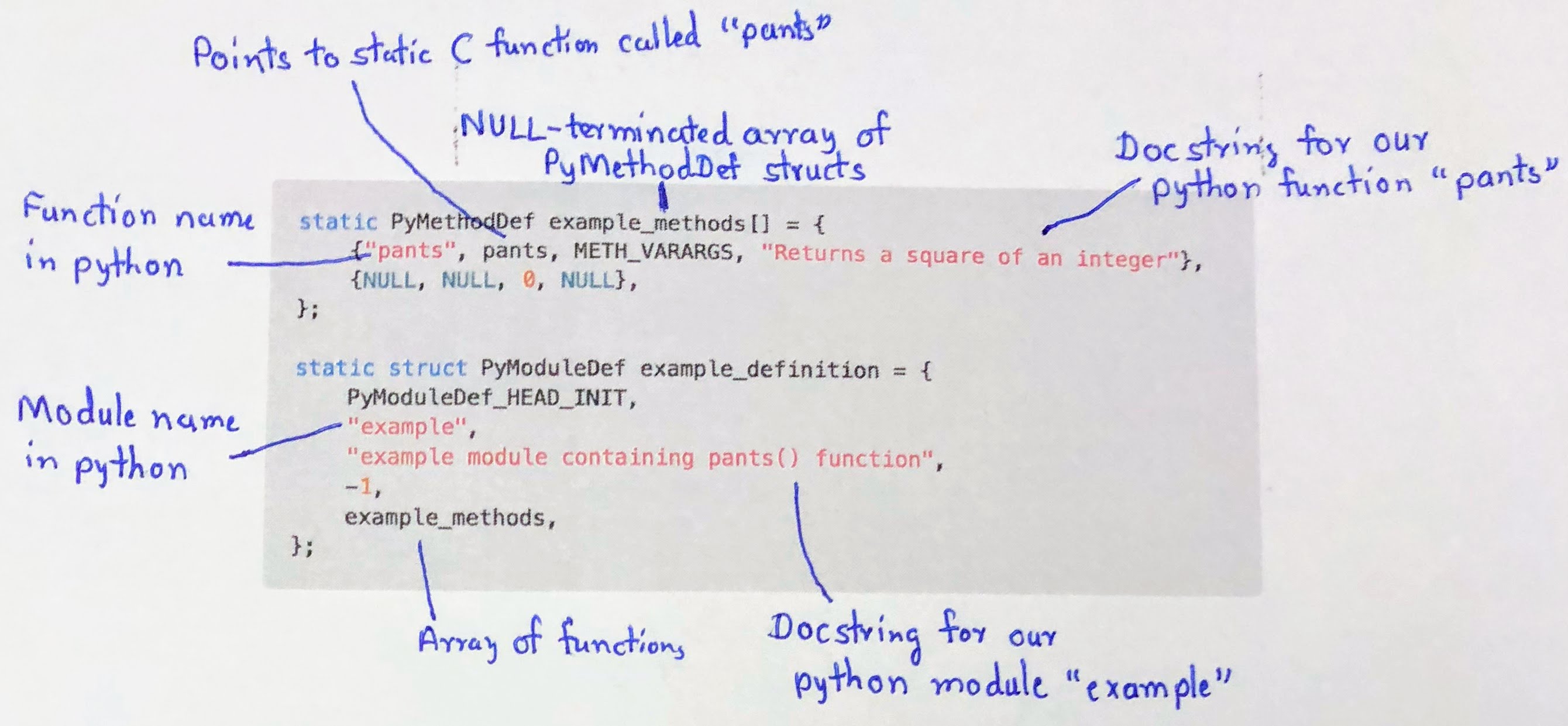
Next is creating our pants function in C/C++:
#include <Python.h>
static PyObject *pants(PyObject *self, PyObject *args) {
int input;
if (!PyArg_ParseTuple(args, "i", &input)) {
return NULL;
}
return PyLong_FromLong((long)input * (long)input);
}
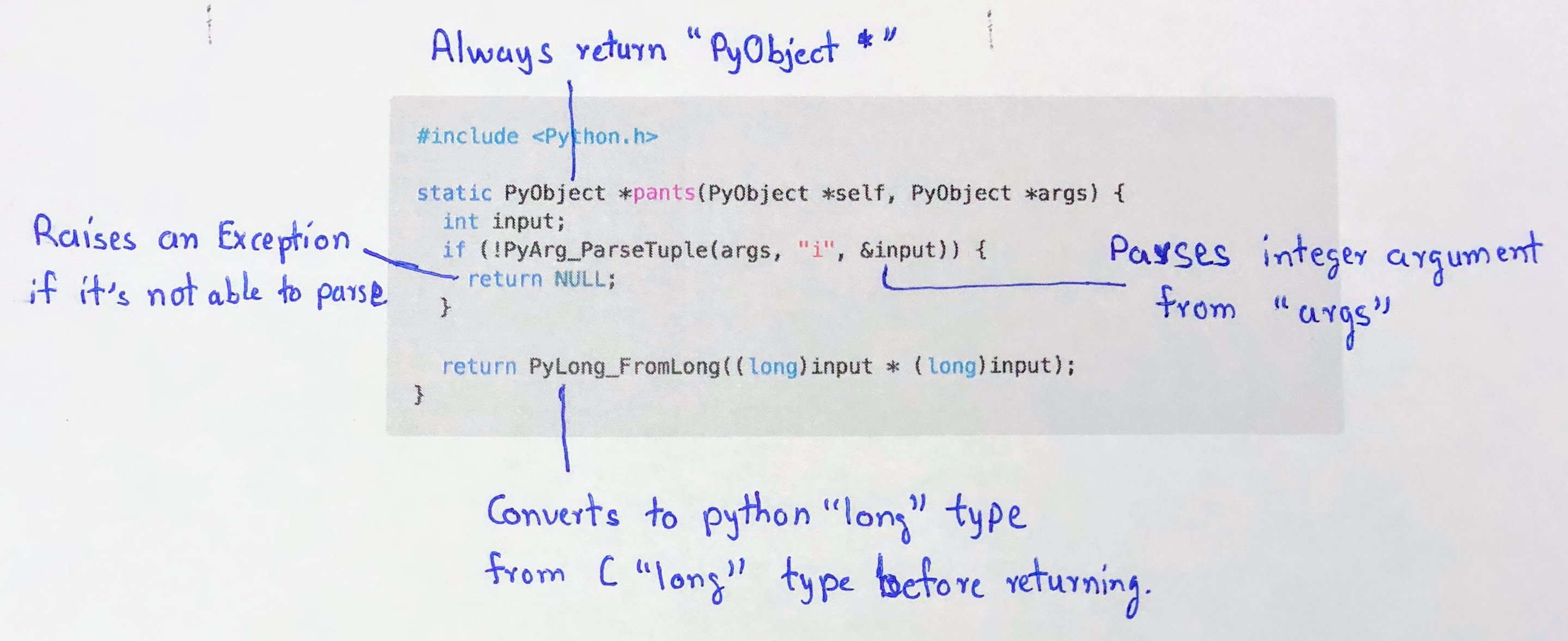
Putting everything together:
#include <Python.h>
static PyObject *pants(PyObject *self, PyObject *args) {
int input;
if (!PyArg_ParseTuple(args, "i", &input)) {
return NULL;
}
return PyLong_FromLong((long)input * (long)input);
}
static PyMethodDef example_methods[] = {
{"pants", pants, METH_VARARGS, "Returns a square of an integer"},
{NULL, NULL, 0, NULL},
};
static struct PyModuleDef example_definition = {
PyModuleDef_HEAD_INIT,
"example",
"example module containing pants() function",
-1,
example_methods,
};
PyMODINIT_FUNC PyInit_example(void) {
Py_Initialize();
PyObject *m = PyModule_Create(&example_definition);
return m;
}
Our setup.py would look something like this:
from distutils.core import setup, Extension
example_module = Extension(
'example',
sources=['example-pants.cpp'],
language='C++', )
setup(
name='example',
version='0.1.0',
description='example module written in C++',
ext_modules=[example_module], )
After creating setup.py and example-pants.cpp, this is how we would install the example package:
python3 setup.py install
In this step, we are compiling the example-pants.cpp file into a .so shared library file. Python is able to read the module info from this shared library.
However, I often prefer to use:
pip3 install -e .
Anyway, you can find this code and more information here - https://github.com/hardikp/pycpp/tree/master/cpython.
Example module with classes
Let’s try to add a class Classy in our example module. Classy class contains two methods: miami() and new_york(). miami() decrease an integer class variable and new_york() increases it.
example module
|-> Classy class
Classy class
|-> miami() method
|-> new_york() method
Adding a new type to a module requires more work. Since C doesn’t have classes, CPython takes a longer route to adding classes. We need to define a struct - that’s our class. In addition to that, we will define our methods miami() and new_york() as static functions. We also need to define the allocator, initializor and destructor as static functions.
Let’s first define the struct for our Classy class.
typedef struct {
PyObject_HEAD // no semicolon
int number;
} Classy;
PyObject_HEAD is a macro pointing to the base class PyObject. number is the class variable we’re adding for our use case.
We need to create a NULL-terminated array of PyMemberDef structs: Classy_members. We will list down the data members of our Classy type.
static PyMemberDef Classy_members[] = {
{"number", T_INT, offsetof(Classy, number), 0, "classy number"},
{NULL} /* Sentinel */
};
Next step is to define the init/delete methods. Classy_dealloc frees the memory. If we had PyObject * members in our Classy struct, we would need to free that memory (i.e. decrease the ref count) before calling tp_free of the type object.
static void Classy_dealloc(Classy *self) {
Py_TYPE(self)->tp_free((PyObject *)self);
}
static PyObject *Classy_new(PyTypeObject *type, PyObject *args,
PyObject *kwds) {
Classy *self;
self = (Classy *)type->tp_alloc(type, 0);
if (self != NULL) {
self->number = 0;
}
return (PyObject *)self;
}
static int Classy_init(Classy *self, PyObject *args, PyObject *kwds) {
self->number = 1;
return 0;
}
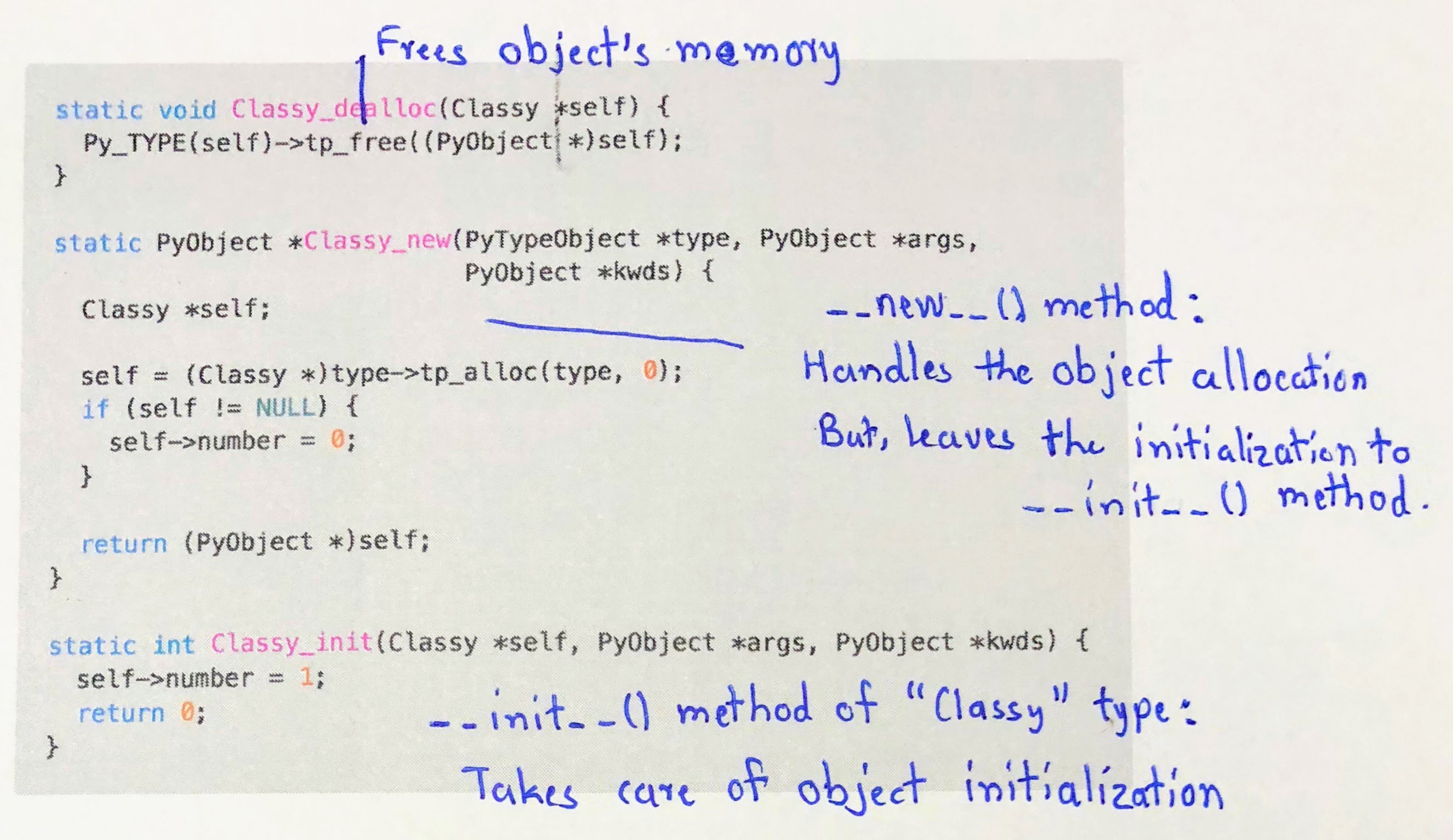
Next step is to define methods for the Classy type. We are defining two methods in the Classy class: miami() and new_york(). PyMethodDef struct at the end is listing those methods - this is how we will let python and compiler know about Classy methods.
static PyObject *Classy_miami(Classy *self) {
if (self->number > 1)
self->number /= 2;
return PyLong_FromLong((long)self->number);
}
static PyObject *Classy_new_york(Classy *self) {
if (self->number < 1024 * 1024)
self->number *= 2;
return PyLong_FromLong((long)self->number);
}
static PyMethodDef Classy_methods[] = {
{"miami", (PyCFunction)Classy_miami, METH_NOARGS, "Divides number by 2"},
{"new_york", (PyCFunction)Classy_new_york, METH_NOARGS, "Doubles number"},
{NULL} /* Sentinel */
};
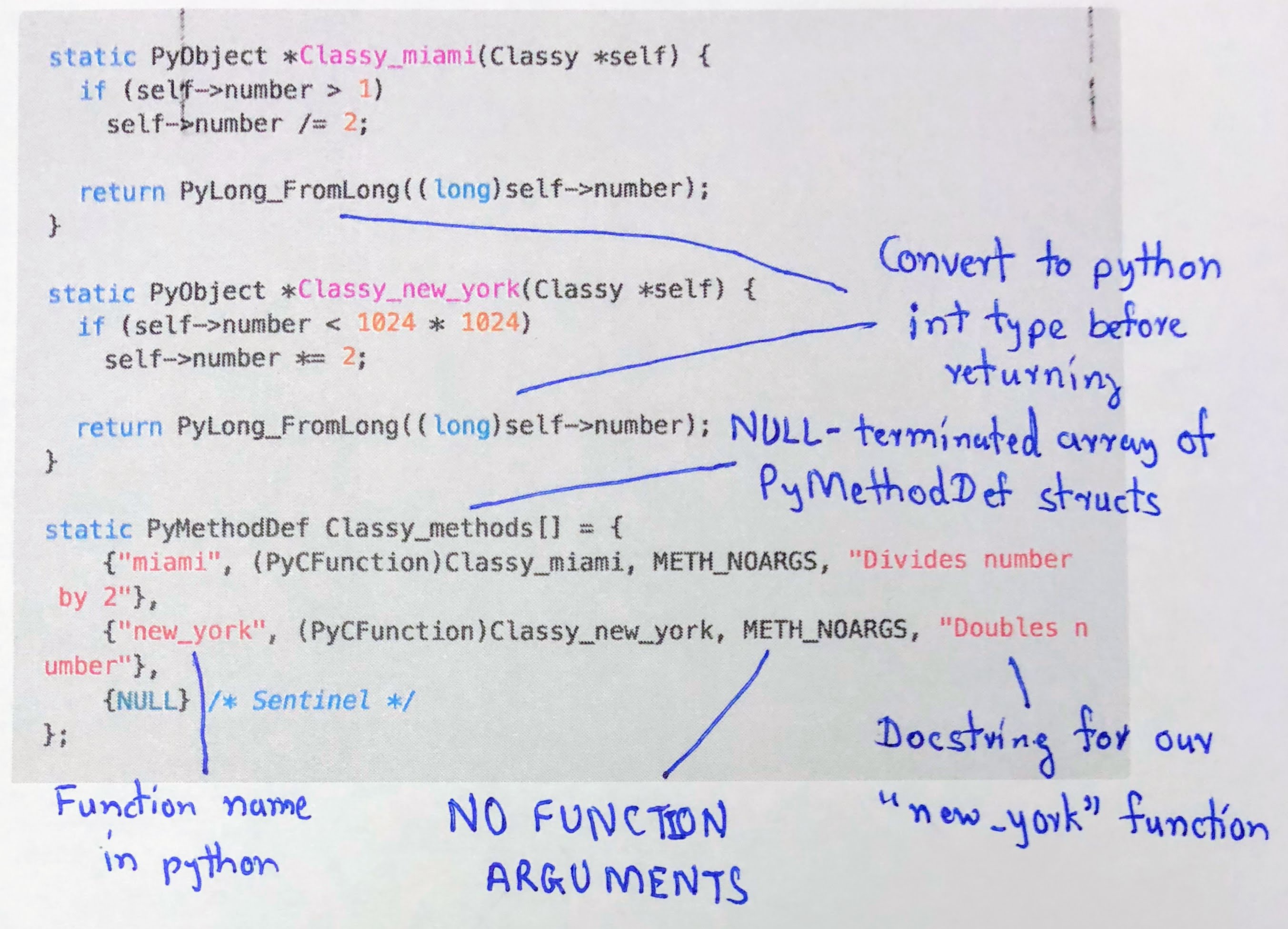
After all of that is done, we define the following struct - this is similar to the PyModuleDef struct from the previous section. Several redundant members of that struct are set to NULL, becase we have not defined customized components.
static PyTypeObject ClassyType = {
PyVarObject_HEAD_INIT(NULL, 0) "example.Classy", /* tp_name */
sizeof(Classy), /* tp_basicsize */
0, /* tp_itemsize */
(destructor)Classy_dealloc, /* tp_dealloc */
0, /* tp_print */
0, /* tp_getattr */
0, /* tp_setattr */
0, /* tp_reserved */
0, /* tp_repr */
0, /* tp_as_number */
0, /* tp_as_sequence */
0, /* tp_as_mapping */
0, /* tp_hash */
0, /* tp_call */
0, /* tp_str */
0, /* tp_getattro */
0, /* tp_setattro */
0, /* tp_as_buffer */
Py_TPFLAGS_DEFAULT | Py_TPFLAGS_BASETYPE, /* tp_flags */
"Classy objects", /* tp_doc */
0, /* tp_traverse */
0, /* tp_clear */
0, /* tp_richcompare */
0, /* tp_weaklistoffset */
0, /* tp_iter */
0, /* tp_iternext */
Classy_methods, /* tp_methods */
Classy_members, /* tp_members */
0, /* tp_getset */
0, /* tp_base */
0, /* tp_dict */
0, /* tp_descr_get */
0, /* tp_descr_set */
0, /* tp_dictoffset */
(initproc)Classy_init, /* tp_init */
0, /* tp_alloc */
Classy_new, /* tp_new */
};
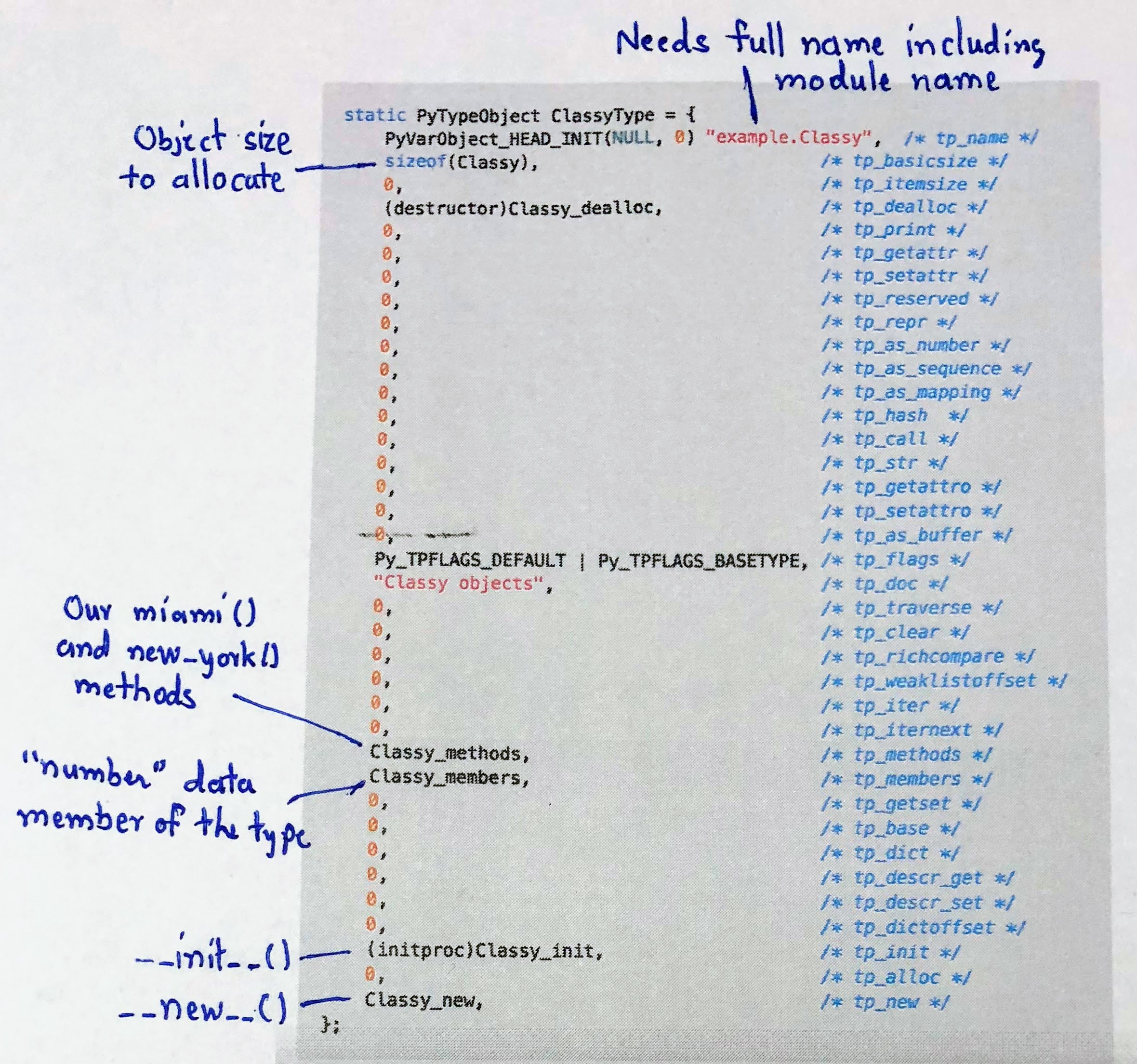
After all of the above is done, this is how we add the type we just defined to our example module:
PyMODINIT_FUNC PyInit_example(void) {
Py_Initialize();
PyObject *m = PyModule_Create(&example_definition);
if (PyType_Ready(&ClassyType) < 0)
return NULL;
Py_INCREF(&ClassyType);
PyModule_AddObject(m, "Classy", (PyObject *)&ClassyType);
return m;
}
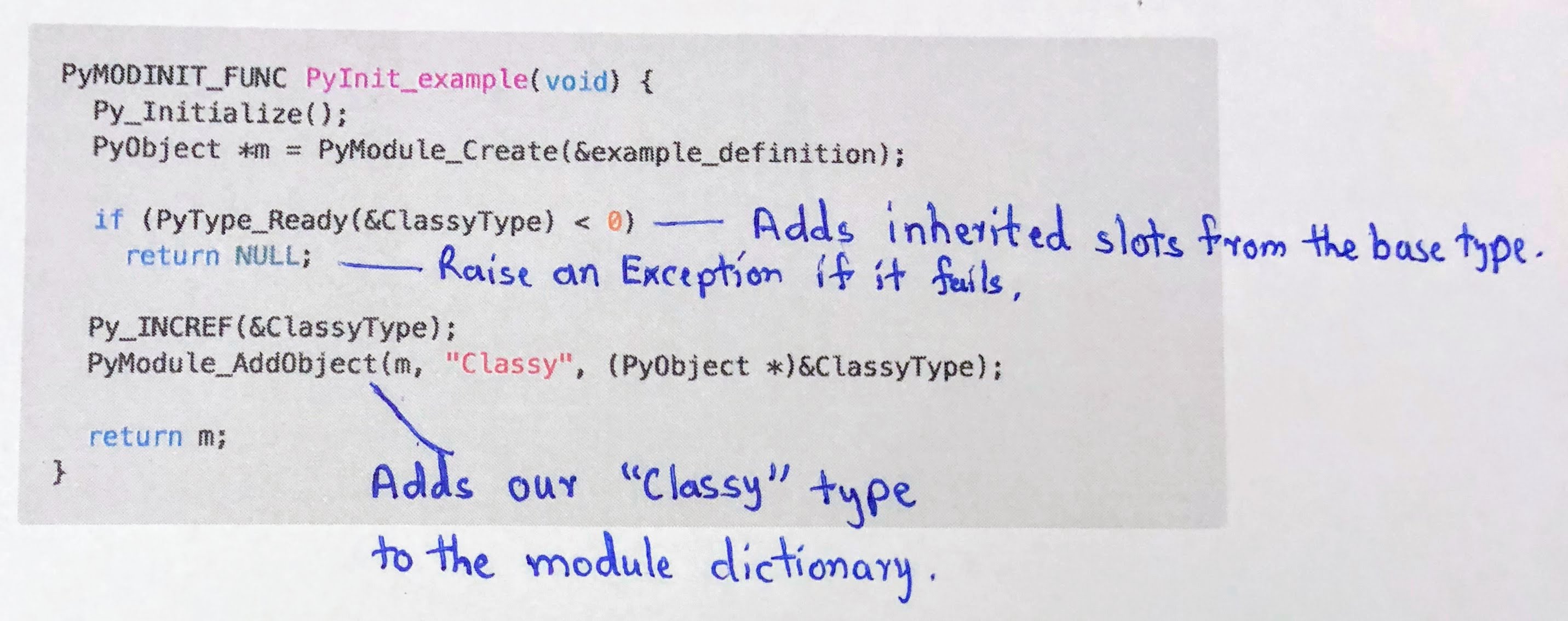
You can find the complete example here.
Notes
- Almost everything shown above is python3 specific.
- We have not explored memory management in this section. Python keeps track of the reference count for each object. Whenever the reference count comes back to 0, that object is freed from the memory.
Py_INCREF,Py_DECREFandPy_XDECREFare the useful macros for this purpose. - There are 2 main ways of extracting arguments in functions. https://docs.python.org/3/extending/extending.html#extracting-parameters-in-extension-functions
METH_VARARGS: This is to process the arguments by position.PyArg_ParseTuple()is used to parse the arguments.METH_KEYWORDS: This is to process the arguments by keywords.PyArg_ParseTupleAndKeywords()is used to parse the arguments.METH_NOARGS: For functions without any arguments.
- We also skipped
list,tupleanddictprocessing.
Links
- https://github.com/hardikp/pycpp/tree/master/cpython
- https://docs.python.org/3/extending/extending.html - Getting started guide
- https://docs.python.org/3/c-api/index.html - Python C API
- https://docs.python.org/3/extending/newtypes.html
- https://gist.github.com/killeent/4675635b40b61a45cac2f95a285ce3c0 - Describes how PyTorch uses C API bindings.
pybind11
pybind11 is extremely simple to use. A major hurdle in adding python-C++ bindings is learning a whole new framework of APIs. CPython, Cython and almost all other options require you to learn the underlying APIs. The biggest advantage of pybind11 is the ability to write normal C++ code and simply use it to export types and functions from a python module. It’s the easiest framework to add C++ bindings.
Let’s get started!
We don’t need to worry about PyObject and other C APIs here. All we need to do is write normal C++ code and use PYBIND11_MODULE to define the module.
#include <pybind11/pybind11.h>
int pants(int i) {
// Return the square
return i * i;
}
namespace py = pybind11;
PYBIND11_MODULE(example, m) {
m.doc() = R"pbdoc(
example module
-----------------------
.. currentmodule:: example
.. autosummary::
:toctree: _generate
pants
)pbdoc";
m.def("pants", &pants, R"pbdoc(
Returns the square of a number
)pbdoc");
m.attr("__version__") = "dev";
}
That’s it! This is all we need to do to create our example module with pants function.
In our setup.py, we need to give the pybind11 include path in the Extension. The rest is pretty much the same.
example_module = Extension(
'example',
sources=['example-pants.cpp'],
language='C++',
include_dirs=[pybind11.get_include(True)], )
Links
- https://github.com/hardikp/pycpp/tree/master/pybind11
- https://github.com/pybind/python_example
- http://pybind11.readthedocs.io/en/latest/